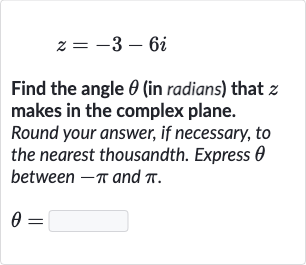Full solution
Q. Find the angle (in radians) that makes in the complex plane. Round your answer, if necessary, to the nearest thousandth. Express between and .
- Identify real and imaginary parts: To find the angle that the complex number makes with the positive x-axis in the complex plane, we need to use the arctangent function, which gives us the angle in radians for a given ratio of the imaginary part to the real part of a complex number. The formula to find the angle is .
- Use atan function: First, identify the real part and the imaginary part of the complex number . The real part is and the imaginary part is .
- Calculate : Now, use the function to find the angle. The function takes into account the signs of both the real and imaginary parts to determine the correct quadrant for the angle.
- Determine the quadrant: Calculate the value of using the atan function.
- Find the angle : The function will return a value in radians. Since the real part and the imaginary part are both negative, the angle will be in the third quadrant. The function will automatically give us an angle in the correct range between and .
- Find the angle : The function will return a value in radians. Since the real part and the imaginary part are both negative, the angle will be in the third quadrant. The function will automatically give us an angle in the correct range between and .After calculating, we find that the angle is approximately radians. This is the angle that makes with the positive -axis in the complex plane, and it is expressed between and .

